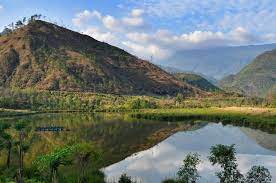Geo-Heritage Sites:

The Geological Survey of India (GSI) has identified certain geological sites across the Northeast for promotion of geo-tourism.
- 12 locations in the Northeast have been included in the 32 approved geo-tourism or geo-heritage sites in the country.
Geo-heritage Sites:
- Geo-heritage refers to the geological features which are inherently or culturally significant offering insight to earth’s evolution or history to earth science or that can be utilized for education.
- Geological Survey of India (GSI) is the parent body which is making efforts towards identification and protection of geo-heritage sites/national geological monuments in the country.
- Some of these sites are: Marine Gondwana fossil park in Chhattisgarh; Siwalik vertebrate fossil park in Himachal Pradesh; Stromatolite park in Rajasthan; Pillow lava in Karnataka, Eparchaean unconformity and Tirumala hills in Andhra Pradesh, Lonar Lake in Maharashtra, etc.
Geo Tourism:
- Geotourism is defined as “tourism that sustains or enhances the geographical character of a place – its environment, culture, aesthetics, heritage, and the well-being of its residents.”
- It will foster community involvement, improve the local economy and create respect for local culture and tradition.
- India is a country with diverse physical attributes, rich cultural heritage and eventful ancient history and its subcontinent exhibits imprints of varied geological processes through ages and is a storehouse of interesting geological features.
Geo-heritage sites in Northeast:
- Majuli (Assam):
- A river “island”, among the world’s largest, in Brahmaputra river.
- The island is also the hub of spiritualism in Assam because of a number of ‘satras’ or Vaishnav monasteries established by the 15th-16th century saint-reformer Srimanta Sankaradeva and his disciples.
- Sangetsar Tso (Arunachal Pradesh):
- It is popularly known as Madhuri Lake.
- It is close to the border with Tibet and was formed due to the damming of a river during a major earthquake in 1950.
- Loktak Lake (Manipur):
- It is the largest freshwater lake in the Northeast.
- The attractions of this lake are the ‘phumdis’ or floating biomass and the ‘phumsangs’ or huts of fishermen on them.
- The Keibul Lamjao National Park, the only floating wildlife habitat on earth, is on the southwestern part of the lake and is the last natural habitat of the sangai or brow-antlered dancing deer.




